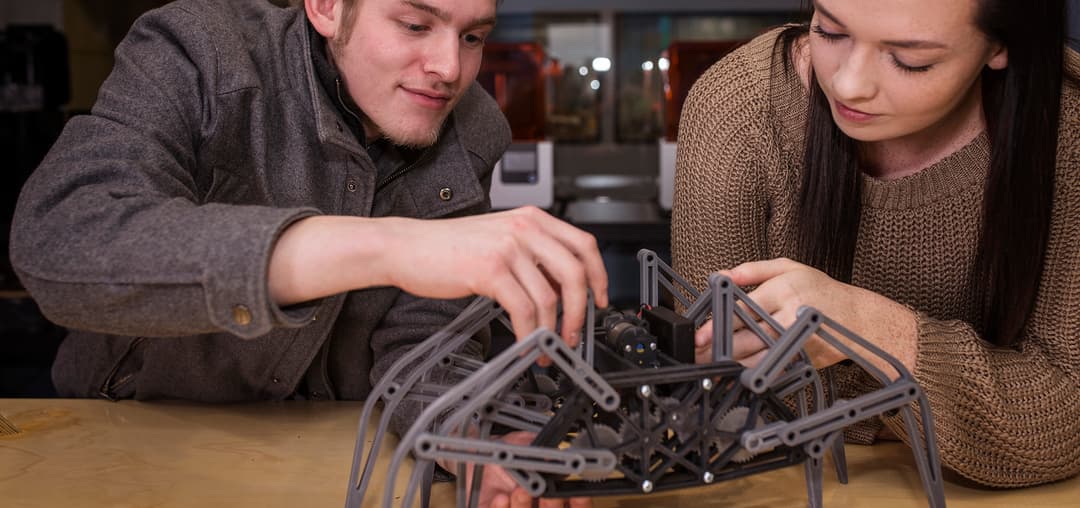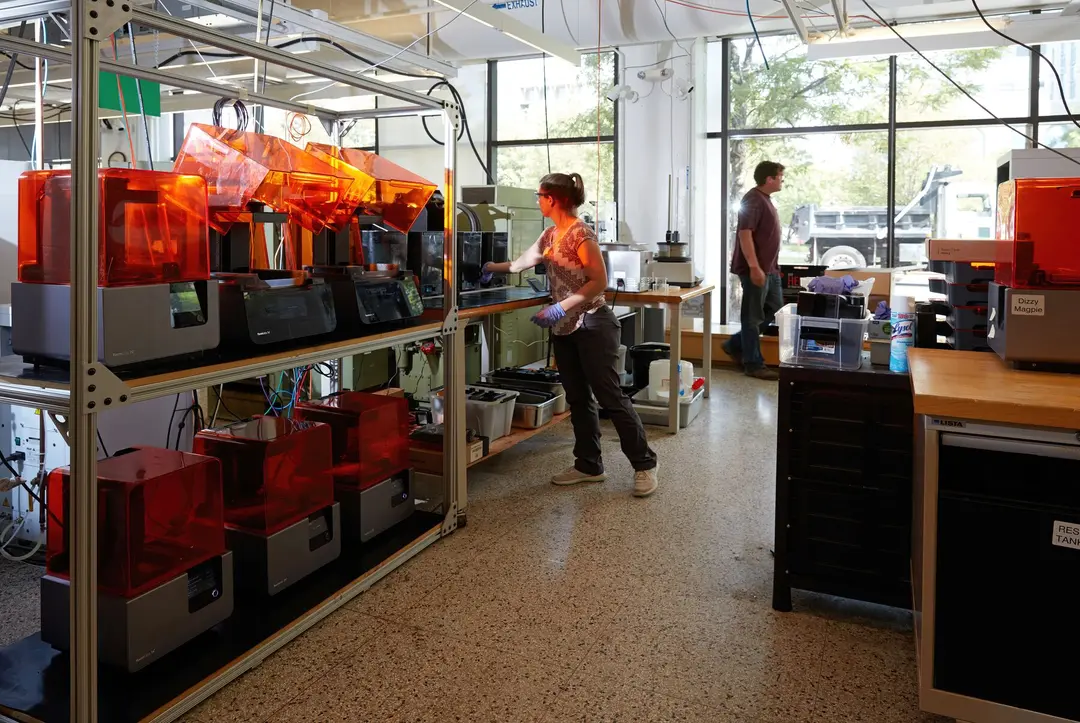How an Architecture Professor Leveraged 3D Printing to Enhance Virtual Classes
Architecture students designed models that Professor Michael Silver printed on the Form 2. Photo courtesy of Silver.
The COVID-19 pandemic has sent multiple industries careening. The service industry is struggling to stay afloat, the travel industry is facing an uncertain summer, arts have moved online, and schools have closed their campuses in favor of virtual learning.
For any student or teacher, the transition from in-person classes to Zoom classes can be rocky, to say the least. For hands-on disciplines like engineering, design, and architecture, classes require more than internet access. Classes in those disciplines involve equipment, machines, and technology. In the new era of social distancing and online learning, teachers in those subjects have to find creative ways to engage their students.
Michael Silver, an architecture professor at the University of Kentucky College of Design and Architecture, found a solution. He bought a Form 2 3D printer to bring his students’ building models to life. Read on to learn more about:
-
The problem Silver solved by using a 3D printer for his architecture class.
-
How Formlabs printers improved learning outcomes.
-
Why 3D printing is the future of education.
Solving Classroom Challenges With 3D Printing
Silver has plenty of experience with 3D printing. In fact, the first time he learned about 3D printing was in the 1980s. “I have my own 3D printers, I do a lot of metal printing in titanium so I have a broad range of experiences around printing across materials and across scales for the last 20 years,” he said. Silver is familiar with a number of 3D printing technologies and machines and was introduced to Formlabs a couple of years ago. The College of Design and Architecture has six Formlabs 3D printers that Silver started using the past spring semester. “This semester, we started using those machines and I was really surprised at the quality of the results and also the reliability of the machine. The machine is incredibly reliable. I haven’t had one failed print,” he said. “The Formlabs [3D printers are] very robust, so just from that experience during this semester, we were familiar enough with the printer that I decided that because of the pandemic, I could pretty much guarantee students models at the end of the review if we got a machine.”
When the COVID-19 pandemic hit right after spring break, Silver scrambled to find a way to teach his introductory architecture class remotely while preserving the hands-on element that is so critical to the class. “Our curriculum is very physical. We need machines, building tools, and laser cutters. So one of the casualties of going through the pandemic was that we couldn’t do much physical modeling or physical objects,” Silver said.
Having already used the Form 2 3D printer, Silver bought one for himself. The class required students to design a chapel for a small site of their choosing. By designing a chapel, students were able to explore a wide range of ideas, spaces, forms, and materialities. Silver’s students sent him STL files of the models they designed with CAD software like Rhino and he printed them out. “They would continue to do design while I managed the printer on our end and then for the final I presented their models, their physical models, and they presented their drawings. So we were able to continue to make physical objects during the period of quarantine,” Silver said. “We didn’t have one model fail on the [Form 2]. Every model came out perfect and so the machine performed really beautifully. And cost effective. In fact, I had bought extra cartridges just in case we ran out of materials but the thing is so efficient, we got so many models per cartridge that we were able to satisfy a class size of 14 students.”
A class size of 14 was able to produce 16 to 17 models in two weeks. “The ability to still physically implement a prototype during quarantine with everybody only meeting through Zoom and doing remote learning, it worked,” Silver said.
Silver’s students were thrilled they had the ability to produce models despite classes shifting from in-person to online. “They were so relieved that they would emerge from this pandemic with something physical because they need to put things in their portfolios that means they need to photograph models,” Silver said. “If you can’t photograph models, you can’t get content for the portfolio.”
How Formlabs’ 3D Printer Improved Learning Outcomes
Originally, Silver thought about transporting his large legacy 3D printer from New York to Kentucky, but that wasn’t feasible--it would require at least three people to get it out of a building. That’s where the Form 2 fits in--its portability made it possible for Silver to set up a printing station in his apartment and get started with printing right away. All Silver had to do was unbox the printer and set it up--the Form 2 was up and running in half an hour.
Professor Michael Silver on Setting up the Form 2
“The portability of the machine was very key. The fact that it’s run off of WiFi made it really easy to set up and since we have very limited space because of the stay-at-home, remote learning restrictions, it was a machine that came into the space, it was very unobtrusive, no cords except for the power cord and again, the dust cover and the lack of noise, no smell, it was like really perfect for kind of sort of an emergency setup. The fact that I could receive files remotely from my students, review them, and then print them out for them...it still is basically able to maintain a connection to the spirit of making physical things, which is so important for an architecture education.”
3D printing encourages iterative design. “The way the 3D printer works in that process is you can constantly update your models and reprint them and see different iterations of how you want your design. And while they had limited time to iterate the models the students did at least have three different models for each one of their projects,” Silver said. “So the 3D printer allows you to incorporate all of your design decisions into a series of models that can show the evolution of the form and that’s great for teaching because the teaching discourse between the student and the faculty can be around how they evolved and how they move from one phase of a project to the next so that kind of discussion has really helped out when you have that at a final. So it’s basically a version of iterative prototyping. Instead of iterating prototypes for industrial design they’re doing it with models for buildings.”
In the process of designing and printing models, Silver said his students learned how to make the models airtight in Rhino 3D, eliminating gaps in surfaces.
Silver added that even though the Form 2 is smaller than some 3D printers he has worked with, it can still support printing large models without compromising quality. Silver praised the resolution and smoothness of the prints. He was so impressed with the detail the Form 2 captured that he started using it for his own projects.
“I’m working on design for a bridge project and the model is extremely detailed. It’s a very detailed mechanical drawbridge. I need much finer resolution for this particular design because it has tiny little screws and all kinds of little, miniature springs and mechanical components and the [Form 2] holds the tolerances I need to deal with those kinds of pieces and at that scale,” he said.
The Future of 3D Printing for Education
The future for 3D printing in education is bright, even in uncertain times. As Silver proved, 3D printing makes a hands-on curriculum possible even when classes are online. Furthermore, his students were engaged and satisfied.
Professor Michael Silver on 3D Printing in Education
“The fact that you can develop a model on the computer rapidly and then see it realized physically is an incredible eye-opening process.”
Formlabs is prepared to serve educators’ needs, from K-12 schools to community colleges and technical schools to colleges and universities.


